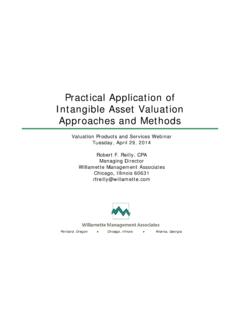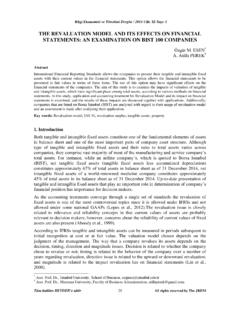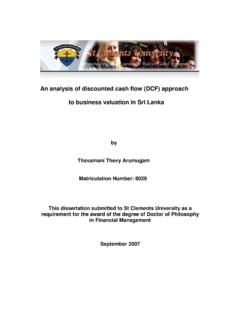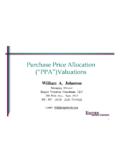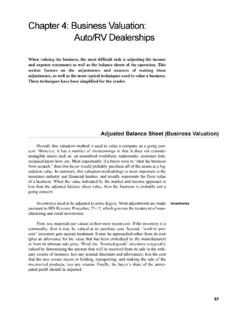Transcription of Purchase Price Allocations Under ASC 805: A …
1 CERTIFIED PUBLIC ACCOUNTANTS,FORENSIC AND FINANCIAL CONSULTANTSP urchase Price Allocations Under ASC 805:A Guide to Allocating Purchase Price for Business Combinations1 Executive BriefWhen your company is on the buy-side of an acquisition, you are burdened with the responsibility of reporting all items related to the transaction on your financial statements. Large companies Under high levels of scrutiny must pay particular attention to how the Purchase Price is allocated to the acquired whitepaper will guide you through the process of allocating Purchase prices for business combinations Under ASC 805. You will learn how to: Identify a business combination Meet acquirer requirements Recognize various intangible assets Select the appropriate valuation method Allocate Purchase prices for income tax purposesFollowing these steps and being precise in your Purchase Price allocation will ensure your company is compliant with GAAP reporting rules and prevent future compliance issues after the acquisition is Prior to June 2001, business combinations were accounted for according to APB Opinion No.
2 16, Business Combinations, which was issued in 1970. Under APB 16, a business combination could be accounted for using either the Purchase method or the pooling of interests method, which had very different treatments of intangible assets. Due to certain ambiguities, the two methods were often misapplied, resulting in drastically different financialstatements for similar business June 30, 2001, the Financial Accounting Standards Board (FASB) released Statement of Financial Accounting Standards No. 141 (SFAS 141), Business Combinations, to simplify accounting for business combinations by requiring virtually all business combinations to be accounted for by the Purchase method.
3 However, SFAS 141 complicated the recognition of intangible response, on December 7, 2007, the Financial Accounting Standards Boards released SFAS 141R, a revision of SFAS 141. SFAS 141R continued the evolution toward fair value reporting and introduced some new accounting concepts involving the definition of a business and a business combination, the treatment of contingent consideration, acquired contingencies, acquisition costs, and restructuring costs. In July 2009, the FASB introduced the Accounting Standards Codification. The Codification superseded most previous US GAAP standards and rendered all literature not included in the Codification non authoritative.
4 FASB Accounting Standards Codification Topic 805 (ASC 805), Business Combinations, became the definitive guidance on business combinations. It combines the content of SFAS 141R, EITF abstracts, FASB staff positions, SEC regulations, SEC staff guidance, and other authoritative guidance on Business Combinations. ASC 805 became effective for business CERTIFIED PUBLIC ACCOUNTANTS,FORENSIC AND FINANCIAL CONSULTANTS2combinations with acquisition dates during financial reporting periods beginning on or after December 15, 2008. BREakIng DOwn Purchase Price Allocations Under aSc 805: Identifying a Business combination Under ASC 805, A business is defined as: An integrated set of activities and assets that is capable of being conducted and managed or the purpose of providing a definition is broad and can result in many transactions qualifying as business combinations when they are actually only asset acquisitions.
5 When determining if a set of assets and activities is a business, the relevant factor is whether or not the integrated set is capable of being conducted and managed as a business and not if the seller operated the set as a business or if the acquirer intends to do so. Unless there is evidence to the contrary, any set of assets that includes goodwill is assumed to be a business. However, the existence of goodwill is not required to meet the definition of a business. If the acquired assets are not a business, the acquirer will account for the transaction asan asset acquisition.
6 A business combination is defined as: A transaction or other event in which an acquiring entity obtains control of one or more definition goes on to explicitly discuss mergers of equals. A change of control can occur without the exchange of consideration or even without the acquirer holding any ownership interest. The acquisition date is defined as the date the acquirer obtains control of the acquiree, regardless of the legal date of the transfer or the date the consideration is a business combination is affected primarily by transferring assets or by incurring liabilities, the acquirer is usually the entity that transfers the assets or incurs the liabilities.
7 If a business combination is affected by transferring equity interests, the acquirer is usually the entity that issues its equity interests. However, in some business combinations, commonly called reverse acquisitions, the issuing entity is the acquiree. In a reverse acquisition the legal acquirer is defined as the acquiree for accounting a business combination occurs because of a bankruptcy reorganization or troubled debt restructuring Under fresh start accounting, the Purchase consideration should take into account the value of the restructured debt. In these cases the original book value of the debt will likely differ from its fair value.
8 Consideration Transferred ASC 805 requires that all consideration transferred be measured at its acquisition date s fair value. The consideration transferred in a business combination is calculated as: assets transferred by the acquirer + liabilities incurred by the acquirer to the former owners + equity issued by the acquirer3 Since the issuance of SFAS 141R, transaction costs are treated as period expenses and not capitalized as part of the Purchase a business combination is achieved without the transfer of consideration, the acquirer would use the fair value of the acquired interest as a substitute for the consideration transferred.
9 Contingent consideration Contingent consideration is an obligation of the acquirer to transfer additional assets or equity interests to the former owners of the acquired business if certain future events occur or conditions are met. Such an obligation would be recorded as a liability on the acquirer s books. Contingent consideration also may give the acquirer the right to the return of previously transferred consideration if specified conditions are met. This right would be recorded as an asset on the acquirer s balance sheet. All contingent consideration is included in business combination accounting and is measured at its acquisition date s fair value.
10 Typically, the fair value of contingent consideration will be determined by estimating the probability of various outcomes actually some cases, contingent consideration will require the seller to perform certain services over the period of the contingency. In such cases, what may appear to be contingent Purchase consideration will actually be compensation. If the future payments are not actually a component of the Purchase Price , they should be accounted for as an expense in future of Intangible assets ASC 805 requires that all identifiable assets acquired, including identifiable intangible assets, be assigned a portion of the Purchase Price based on their fair values.


